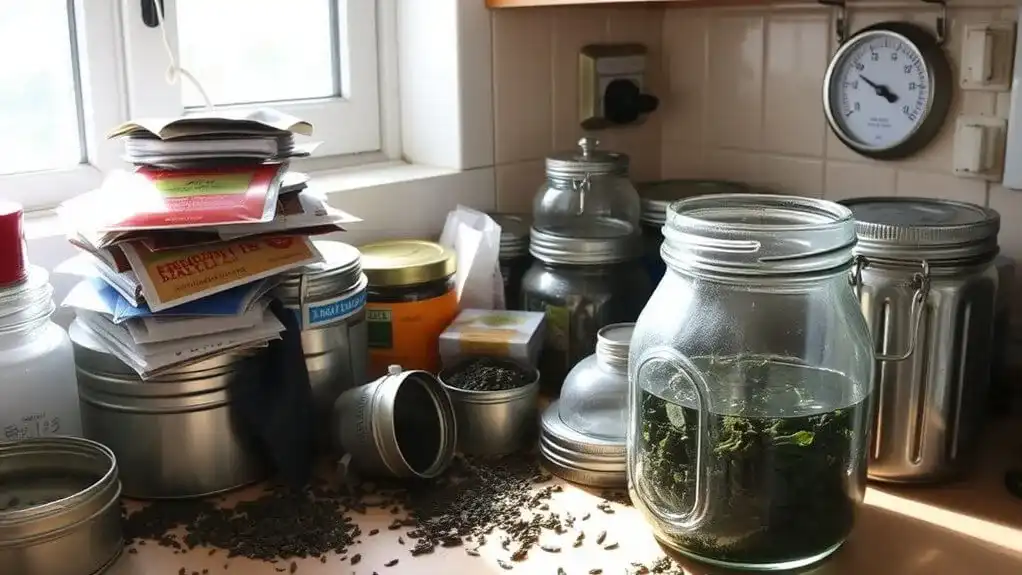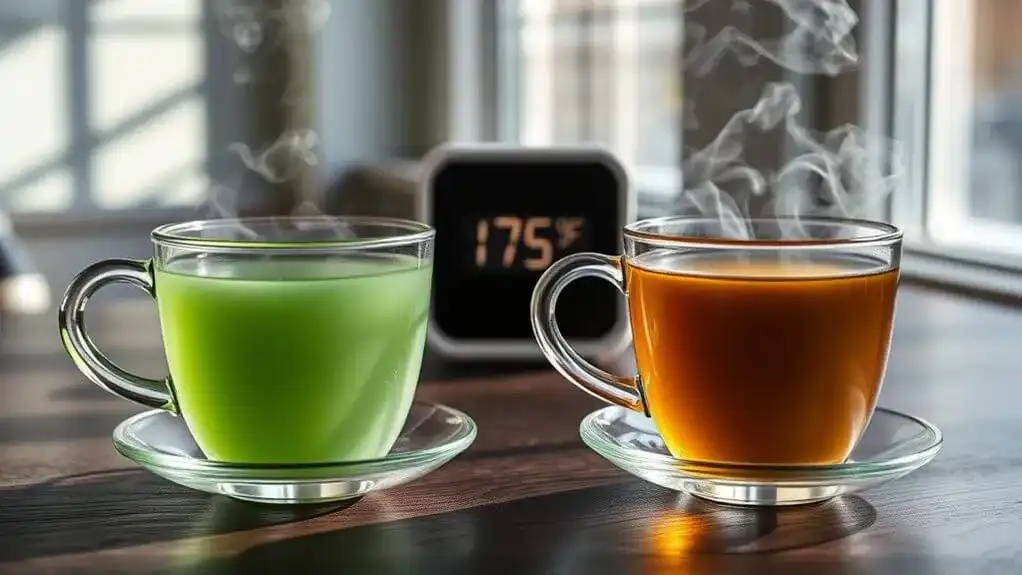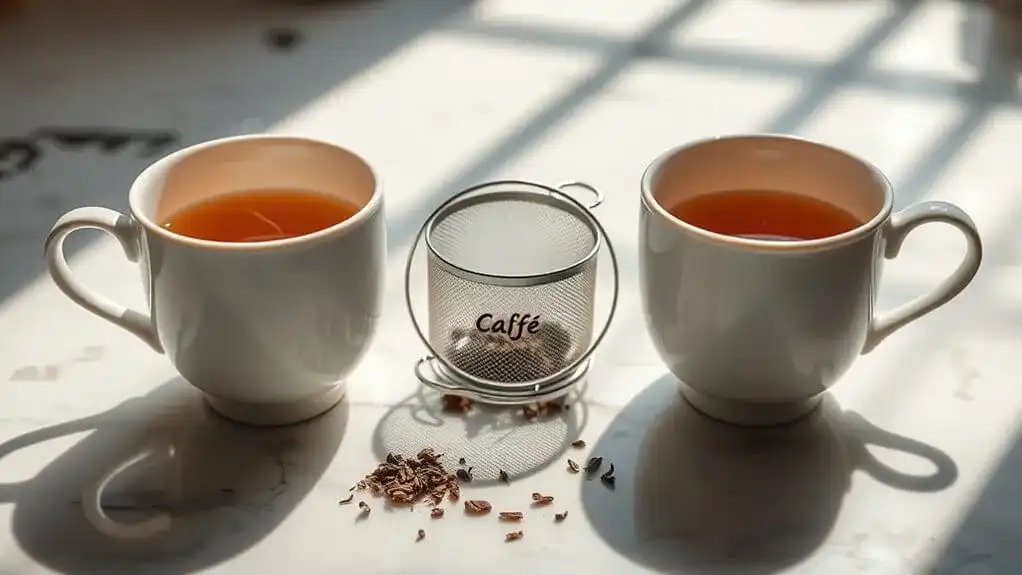Common tea storage mistakes can quickly ruin even premium teas. Many people store their tea in kitchen cabinets where heat, moisture, and cooking odors degrade quality. Clear containers expose delicate leaves to damaging UV rays, while plastic storage can transfer unwanted flavors. Tea needs a cool, dark place with stable temperatures and proper humidity levels in opaque, airtight containers. Understanding these fundamentals will transform how tea lovers protect their cherished collections.
Key Points
- Storing tea in plastic containers or clear jars exposes it to harmful UV rays and chemical contamination – use opaque ceramic or tin instead.
- Keeping tea in kitchen cabinets subjects it to temperature swings, moisture, and cooking odors – store in a dedicated space away from cooking areas.
- Using containers with poor seals allows moisture and air to degrade tea quality – choose airtight vessels that maintain proper humidity levels.
- Exposing tea to temperature fluctuations above 77°F accelerates oxidation – maintain stable, cool storage conditions for optimal preservation.
- Mixing different tea varieties in shared containers compromises unique flavors – store each type separately in appropriate packaging.
The Hidden Dangers of Light and Heat Exposure

Two major threats can quickly diminish your tea's quality: light and heat exposure. Light degradation breaks down aromatic compounds and triggers photo-oxidation, causing chlorophyll to deteriorate while destroying delicate flavors and aromas. When tea is stored in transparent containers, light can also generate unwanted heat, further accelerating the damage.
Heat effects are equally detrimental to tea's integrity. Temperatures above 25°C (77°F) speed up oxidation and break down essential oils, leading to stale flavors and loss of aromatic qualities. When tea is stored near kitchen appliances or in direct sunlight, these harmful reactions intensify. Volatile compounds like linalool and geraniol are particularly susceptible to degradation from heat exposure. To protect tea's quality, it's vital to use opaque containers like tin or ceramic, store them in dark locations, and maintain cool temperatures. Proper storage prevents both light and heat from compromising tea's cherished characteristics. The best practice is to use vacuum-sealed bags for maximum protection against environmental factors.
Why Your Kitchen Cabinet Could Be Ruining Your Tea
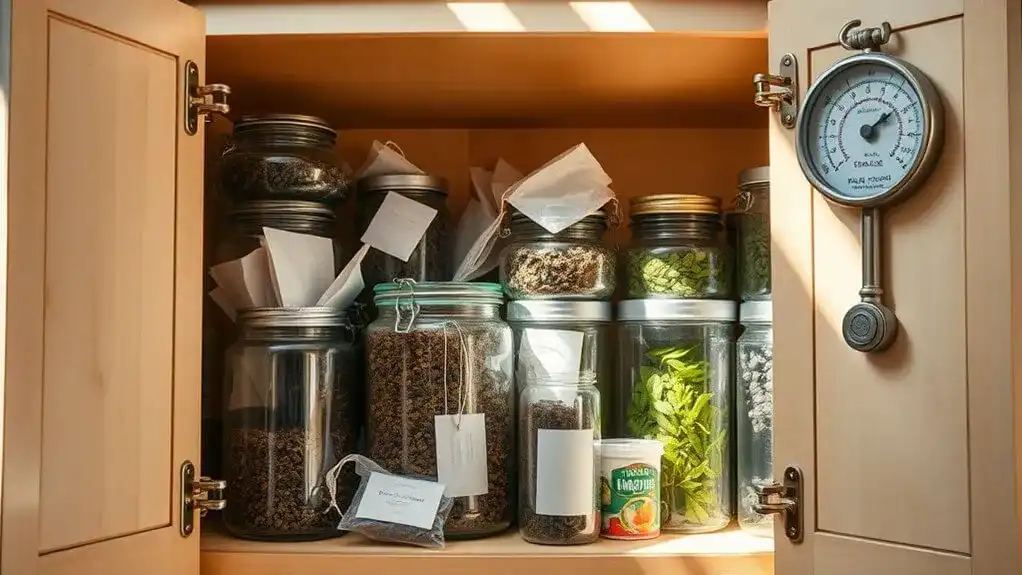
While many tea enthusiasts store their prized leaves in kitchen cabinets, these common storage spots can actually compromise tea quality. The constant temperature fluctuations from cooking and nearby appliances create an unstable environment that can degrade tea leaves. Even worse, kitchen cabinets near sinks and dishwashers expose tea to excess moisture, leading to potential mold growth. Ideal tea storage requires room temperature conditions between 68-77°F.
Proper cabinet organization and humidity control are essential for maintaining tea freshness. Tea stored in these spaces often absorbs strong cooking odors, altering its natural aroma and taste. Additionally, cabinets with poor air circulation trap moisture and unwanted scents, further damaging the tea's quality. Using hermetic storage containers can help protect tea from these harmful environmental factors. For better preservation, tea enthusiasts should consider relocating their collection to a dedicated storage area away from the kitchen's volatile conditions and implementing proper organizational systems. Organizing tea with pull-out drawer storage makes it easier to locate and access different varieties while maintaining their quality.
The Truth About Moisture and Tea Storage
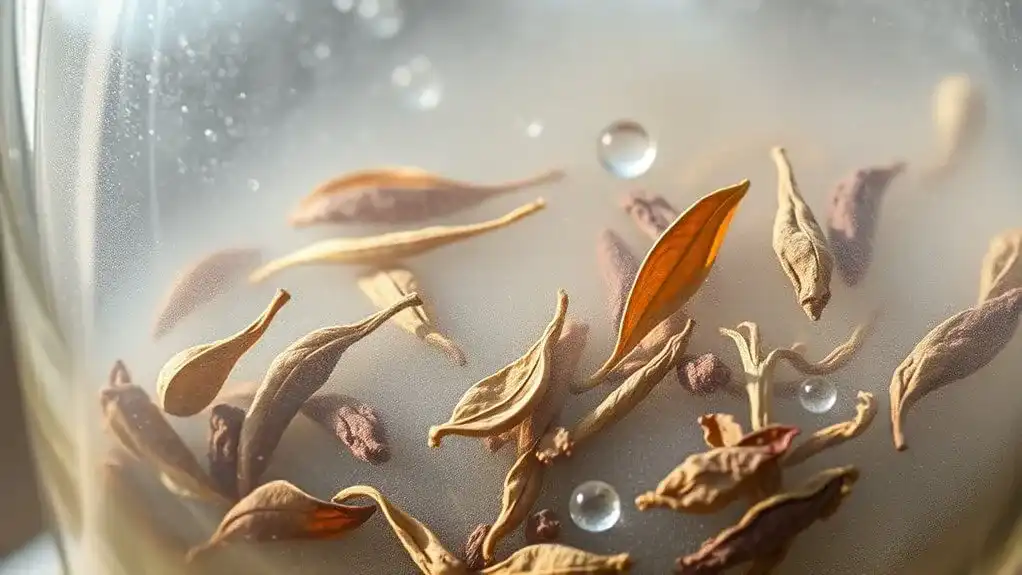
Understanding moisture's role in tea storage can make the difference between preserving your tea's distinct flavors and inadvertently ruining your collection. Proper humidity control is vital, as tea naturally absorbs moisture from its environment, maintaining a delicate balance between 3-6% moisture content. Tea's natural ability to act as a deodorizing agent makes it particularly susceptible to environmental moisture.
Most teas thrive in environments with 40-60% relative humidity, though some varieties like Pu'erh and certain oolongs benefit from slightly higher moisture levels of 60-70%. It's essential to recognize that absolute humidity, not just relative humidity, plays a significant role in storage. Hot air holds more moisture than cold air, which can accelerate aging and potentially lead to mold if not properly monitored. Indoor storage conditions offer better control over temperature and humidity fluctuations compared to outdoor environments. Consider using metal or ceramic containers instead of glass or plastic for optimal preservation.
Using airtight containers creates a protective microclimate that shields tea from excessive moisture levels while allowing it to age gracefully.
Common Container and Packaging Blunders
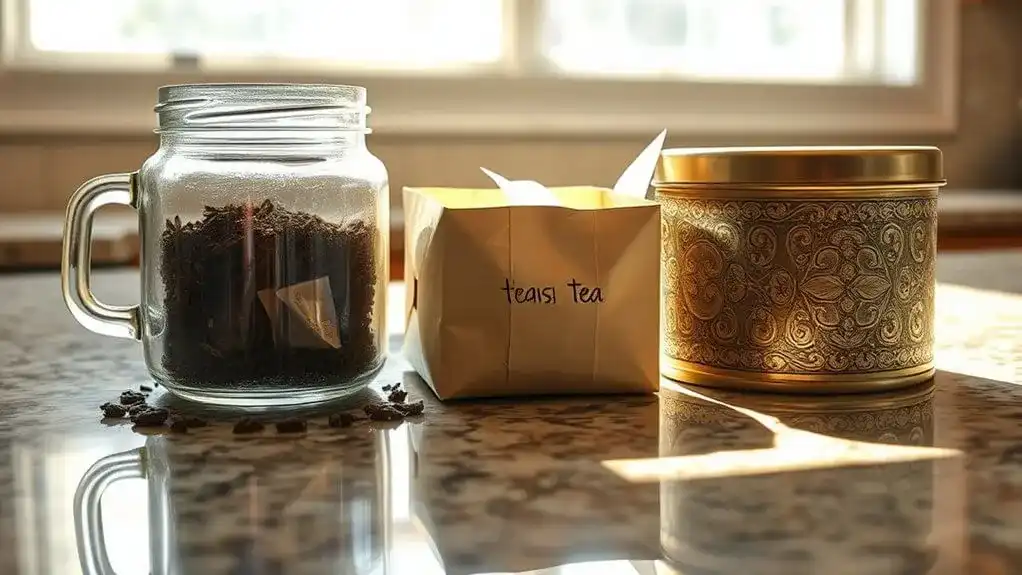
Three critical container mistakes can quickly deteriorate your tea's quality, no matter how carefully you've selected your leaves. Using the wrong container materials, like plastic or Tupperware, can impart unwanted flavors, while clear containers expose tea to harmful UV rays. Poor packaging design choices often lead to improper sealing, allowing air to compromise freshness. Storing tea near areas with high humidity levels can significantly degrade its quality and promote mold growth. Selecting sustainable and biodegradable packaging options has become increasingly important for eco-conscious tea consumers. Strong odors from nearby items can penetrate containers and taint tea flavors permanently.
Common storage blunders to avoid include:
- Using plastic bags that offer minimal protection against light, moisture, and heat
- Choosing containers with complex, impractical designs that make access difficult
- Selecting non-durable packaging that can't withstand transport and handling
- Storing tea in containers that aren't properly sized, leading to excess air exposure
To preserve tea's quality, opt for opaque, airtight containers made from appropriate materials, and guarantee the packaging design prioritizes both functionality and protection.
Simple Steps for Preserving Tea's Delicate Flavors

To preserve your tea's delicate flavors, implementing proper storage techniques is essential for maintaining its quality and freshness. Start by keeping tea in opaque, airtight containers that block harmful UV rays and prevent moisture absorption. Store these containers in a cool, dark place where proper temperature remains stable, as fluctuating temperatures can trigger oxidation and compromise flavor. Additional aromas from nearby items can permanently alter your tea's taste profile. Using tin or porcelain containers provides optimal protection for most tea varieties.
For aroma protection, keep tea away from strong-smelling foods and spices, as it readily absorbs surrounding odors. Choose storage locations with low humidity and use containers specifically designed for tea storage to prevent contamination. Green tea and matcha require extra care – store them in the coolest part of your pantry or kitchen. Different varieties of tea can last anywhere from six months to decades, depending on the type and storage conditions. These simple steps will help maintain your tea's original taste, color, and aromatic properties for an extended period.
Conclusion
While proper tea storage might seem straightforward, it's these small mistakes that silently steal your tea's precious flavors day after day. The good news? Armed with the right knowledge about light, heat, moisture, and containers, you'll never have to settle for stale, lifeless tea again. Don't let another cup fall victim to poor storage habits – your perfect brew awaits with these simple yet essential adjustments.
